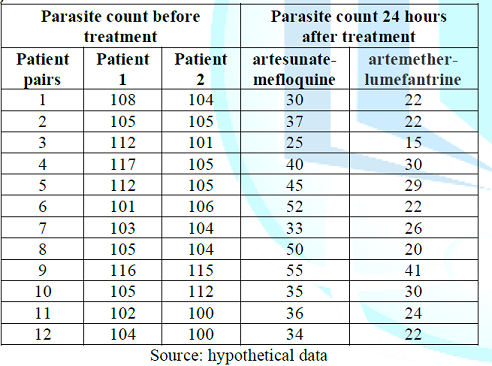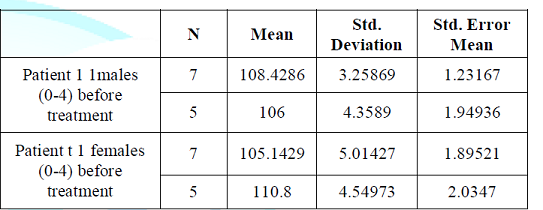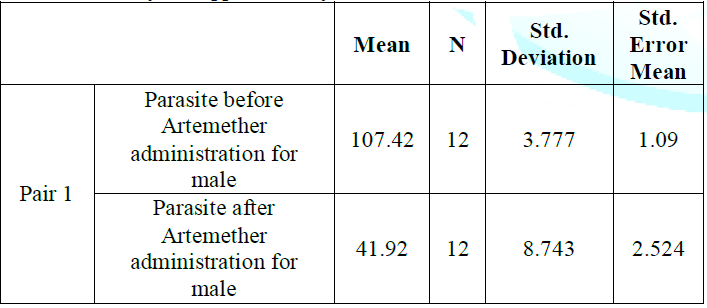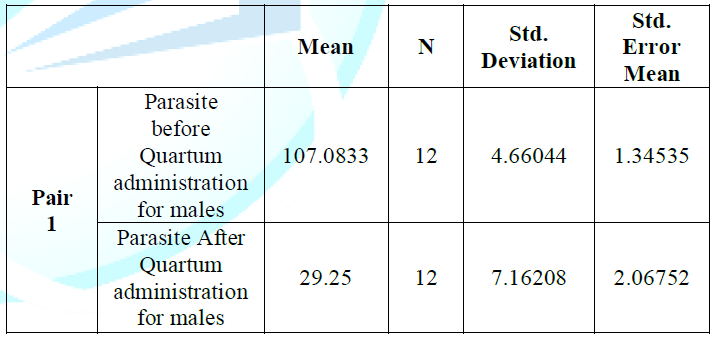Research Article :
Comparison of regimen efficacy in clinical medicine has been
utilized to improve the effect of drugs against disease The pairs alternative
t-test method approach is used in this experimental study to derive efficacy
estimates of two anti-malarial regimens. This study aimed at comparing mostly
used drugs against malaria in Africa in the present time, namely
artesunate-mefloquine and artemether-lumefantrine to determine which of them is
more effective treatment of the disease among children under 5 years of age and
thus may be considered as a first line treatment, especially when laboratory
tests are not available. The results achieved in this study were based on
hypothetical experimental data. The data which represented 12 pairs of matches
children were analyzed using t tests with the help of SSS program. The study
concluded that artesunate-mefloquine is more effective as a first line
treatment than artemether-lumefantrine in children less than five years age of
both sexes. The
main objective of this study is to enhance methodology in epidemiological
research and illustrate a procedure to test therapeutic responses post
anti-malarial treatment of two regimens. The purpose of this kind of study is
to illustrate to young researcher in the heath field who are not familiar with
statistical experimental design how to measure and compare anti-malarial
clinical efficacy. Many studies have been made to test the superiority of a
traditional drug against another drug [1]. This has become a routine for
pharmacists to test their drugs. Malaria in Africa has, especially, become a
problematic endemic disease resisting various kinds of drugs and such
statistical tests are continuously needed in any attempt to control the
disease. For this reason the study aimed at comparing two mostly used drugs
against malaria in the present time, namely artesunate-mefloquine and
artemether-lumefantrine to determine which of them is more effective treatment
of the disease among children under 5 years of age. Rapid treatment of malaria
is necessary to avoid life-threatening complications, especially in the absence
of laboratory tests, so comparing the two most important treatments currently
in use in most African countries in the malaria zone will enable us to identify
the best treatment as a first line to treat malaria in such cases. The study is
basically concerned with explaining the methodology rather than obtaining
robust results. The
normal distribution, also known as the Gaussian distribution, is a probability
distribution most often used to describe the behavior of a variable clustered
around a mean. When graphed, it takes the shape of a bell curve where the peak
of the bell is the mean μ, and the width is determined by the standard
deviation σ. The equation Calculate
a normal distribution is, where the standard normal distribution occurs when
mean =0 and variance=1. By virtue of the central limit theorem (which states
that the distribution of the mean of a large data set tends to a normal
distribution), the normal distribution is very useful in statistical analysis
of populations and is often encountered in natural sciences [3]. ·
The expected value of a normal random variable X is E(x) = μ. ·
The variance of a normal random variable X is Var(x) = σ2. ·
The moment generating function of a normal random variable X
is defined for any t ∈ℝ : The main problem here is that the standard deviation is
unknown and it is necessary to use the sample standard deviation but this needs
the following amendment. To find the corresponding distribution we start with
the joint probability density function for the variables (s, t). Where x has a
standard normal distribution with parameters 0,1 and y has a gamma distribution
with For
- ∞ < x < ∞ and y > 0, and f(x, y) = 0 elsewhere, hence For Table 1, click below The
t Test for Pairs (Equal Samples): The t test for pairs is used when the
sample size is too small and the variance of the distribution of pairs is not
known. Such usage of small sampling theory in clinical medicine is governed by
a number of axioms that have to be satisfied when selecting the sample. These
axioms are:- 1-The selected sample pairs have to be in the same age range. 2- The selected sample pairs have to be of the same sex. 3-
The selected sample pairs have to be of the same prognosis. 4-
Occupation period of the disease should approximately be equal for the selected
pairs patients. The
satisfaction of the axioms above are more important that the sample size. [5] Data
To
collect data on comparative treatments effect is always a complicated task.
This especially true when comparing the effect of two anti-malarial drugs. The
difficulty arises for a number of reasons 1-
If the plasmodium
parasite is scanty, it does not appear in the blood film after taking any
of the anti-malarial drugs although it is present in the patient blood. This is
a characteristic of people who are repeatedly infected by malaria.
For this reason the study should include in the experiment patients who develop
the disease for the first time with severe but uncomplicated symptoms. 2-
While the treatments are different in two groups, researchers should try to
keep as many of the conditions the same as possible. The alternative pairs who
will be given the two drugs alternatively should be of the same age group, same
sex and having the same prognosis. 3-The
inclusion criteria of severe malaria means that only patients with an account
of malaria parasite in 100 fields of an oil emersion lens should have a mean
number of parasites of 30 and over to satisfy normality assumption . Under such
criteria the size of the comparison sample cannot be large because the
researcher has to wait for a patient with all the above characteristics to
report to health facility. This means that samples are longitudinal in nature. 4-
Because samples sizes will be very small, the researcher will have to use small
sampling theory tests such as t-student, chi-square
or F test. Such framework can only be applied in clinical medicine where
experiments are highly controlled. This makes things even more complicated
because the patients should be inpatients. Moreover, the researcher should have
agreement of collaboration of a doctor and a pathologist working in the
facility, in addition to strict ethical considerations and of course financial
support. A
hypothetical trial experimental trial is presented here to illustrate the
application of the procedure using SPSS program. The bench mark parasite
counts per 100 fields for hypothetical cohorts of male and female children 0-4
years are based on educated guessing. Treatments to be compared are
artesunate-mefloquineandartemether-lumefantrine. The hypothetical cohorts are
presented in tables (4and 5) successively. Each table shows Parasite count
before treatment and Parasite count 24 hours after treatment. The
results shown here are, of course, illustrative. All results are based on
output from SPSS Package: To remind the reader, our experiment involves two
outcomes. Malaria parasite count in 100 fields of an emersion lens for twelve
pairs of male children represents experiment 1 denoted in the analysis as
“patient1”. Similar experiment for females is denoted as” patient 2.” Test
of independence between males and females samples: Tests the significance
of the difference between the two samples means. The procedure provides
descriptive statistics for each test variables together with a test of variance
equality and a 95% confidence interval for the difference. The two variables
involved in our study are the parasite densities of males and females before
taking any treatment in the first experiment (patient1). For simplicity
artesunate-mefloquine is referred to as “Quartum” and artemether-lumefantrine
as” Artemether”. Usually,
the groups in a two-sample t test are fixed by design, and the grouping
variable has one value for each group. However, there are times when assignment
to one of two groups can be made on the basis of an existing scale variable.
[6]. With the Independent-Samples t- Test procedure, all we need to provide is
a cut point. The SPSS program divides the sample in two at the cut point and
performs the t test. The virtue of this method is that the cut point can
easily be changed without the need to re-create the grouping variable by hand
every time. The procedure first produces table (2) below. The
descriptive table displays the sample size cut of points, mean, standard
deviation, and standard error for both groups. On average parasite count for
males (3.5 units of the mean) is less than the comparison group (females), and
they vary a little less around their standard deviations. The
procedure produces two tests of the difference between the two groups, table
(3). One test assumes that the variances of the two groups are equal and the
other assumes that they are not. The procedure produces t-test for both.
The average significance value of the statistic is 0.191. Because this value is
greater than 0.10, we can assume that the two groups have equal variances and
ignore the second test. The
95% Confidence Interval of the Difference provides an estimate of the
boundaries between which the true mean difference lies in 95% of all possible
random samples of 12 pairs. Since the significance values of the test are
greater than 0.05, we can safely conclude that the average of 0.191 malaria
parasites per 100 fields is not due to chance alone and the assumption that the
two sample means are equal cannot be accepted. Hence the two samples are
independent. The same test was done for experiment two (patient 2) and arrived
to the same conclusion i.e. the two samples are independent. The
Paired-Samples T Test procedure compares the means of two variables for single
pairs. The procedure computes the differences between values of the two
variables for each case and tests whether the average differs from 0. In this
study on comparative malaria treatment, number of parasites per 100 fields of
an oil emersion lens are counted at the beginning of the study, given
treatment1, (a) and measured again. The same procedure was repeated for
treatment2 (Quartum). A third comparison is done for both treatment after
taking the drug and test that the difference does differ from 0. Thus, each
subject has two counts, often called before and after measures and after
treatment for both. An alternative design for which this test is used is a
matched-pair (see chapter one for pairs matching criteria) in which each record
in the data file contains the response for the patient and also for his or her
matched pair. It is the second procedure that is used here. The
procedure provides statistics: for each variable: mean, sample size, standard
deviation, and standard error of the mean. For each pair of variables:
correlation, average difference in means, t test, and 95% confidence interval
for mean difference (one can specify the confidence level). The
descriptive table (4) displays the mean, sample size, standard deviation, and
standard error for both groups. Across all 12 pairs, parasite load dropped
substantially, a drop of 61% after 24 hours from taking Artemether. Now we have
to confirm that this large drop is not due to chance. But before that we
have to establish that the variables under the study are approximately normal. The
tests of normality overlay a normal curve on actual data, to assess the fit. A
significant test means the fit is poor. For Patient1 (parasite load before
treatment - males) the test is not significant; they fit the normal curve well.
The conclusion applies for patient 2. (Parasite load before treatment - females).
These are the original pairs which are normally distributed so are any other
distributions based on them.We test whether the proportion of parasites in the
blood follows normal distribution. The test results are shown in table (5).
Both have no significance according Kolmogorov-Smirnov and Shapiro-Wilk tests
suggesting that both are approximately normal. Analyses
for Males The
descriptive table (8) displays the mean, sample size, standard deviation, and
standard error for both groups. Across all 12 pairs, parasite load dropped
substantially, a drop of 78% after 24 hours from taking Quartum. Now we
have to confirm that this large drop is not due to chance. The test begins by showing correlation for Quartum before
and after .at 0.609 the correlation between before treatment and after
treatment levels is t statistically significant. Levels were slightly above
medium overall; the change was slightly consistent across subjects. See table
(9). In
table (10) the Mean column in the paired-samples t test table displays the
average difference in parasite count for Quartum experiment between before and
after treatment. The
Std. Deviation column displays the standard deviation of the average difference
score. The Std. Error Mean column provides an index of the variability one can
expect in repeated random samples of 12 patients as in this study. The 95%
Confidence Interval of the Difference provides an estimate of the boundaries
between which the true mean difference lies in 95% of our sample of 12. The t
statistic is obtained by dividing the mean difference by its standard error. The
Sig. (2-tailed) column displays the probability of obtaining a t statistic
whose absolute value is equal to or greater than the obtained t statistic.
Since the significance value for drop in parasite is less than 0.05, we can conclude
that the average drop of 78% of parasite per patient is not due to chance
variation, and can be attributed to the Quartum. The
conclusion from this is that Quartum is a very effective drug for malaria
treatment among male children 0-4. The same tests were performed for females
children which indicated that Across all 12 pairs, parasite load dropped
substantially, a drop of 80% after 24 hours from taking Quartum with even
higher correlation (0.795) and a significant difference from 0. Comparison
between Quartum and Artemether for males: The descriptive table (11)
displays the mean, sample size, standard deviation, and standard error for both
groups. For both treatment parasite loads dropped. The percentage difference of
the dropped is 71% in favor of Quartum. Now we have to confirm that this large
drop is not due to chance. The
test begins by showing correlation for parasite after Quartum and Artemether
administration at (-0.357) the correlation between the Quartum treatment and
Artemether treatment levels is inverse butt statistically insignificant. Levels
were lower overall, but the change was inconsistent across subjects. See table
(12).
In
table (13) the Mean column in the paired-samples t test table displays the
average difference in parasite count for Quartum and Artemether experiment
after treatment. The
Std. Deviation column displays the standard deviation of the average difference
score. The Std. Error Mean column provides an index of the variability one can
expect in repeated random samples of 12 patients as in this study. The 95%
Confidence Interval of the Difference provides an estimate of the boundaries
between which the true mean difference lies in 95% of our sample of 12. The t
statistic is obtained by dividing the mean difference by its standard error. The
Sig. (2-tailed) column displays the probability of obtaining a t
statistic whose absolute value is equal to or greater than the obtained t
statistic. Since the significance value for drop in parasite is less than 0.05,
we can conclude that the average drop of (71%) of parasite per patient
is not due to chance variation, and can be attributed to the treatment. The
conclusion from this is that Quartum is more effective drug for malaria
treatment among males children 0-4 than Artemether. The conclusion from this is
that Quartum is a very effective drug for malaria treatment among male children
0-4. The same tests were performed for females children which indicated that
across all 12 pairs, parasite load dropped substantially, a drop of 80% after
24 hours from taking Quartum with moderate correlation (0.524) and a
significant difference from 0. The conclusion to be drawn from this is that
Quartum is more effective drug for malaria treatment among females children 0-4
than Artemether. At present, probably the most common drugs commonly used, at last in Africa,
and has some potency are the so-called artesunate-mefloquine and
artemether-lumefantrine, but this does not prevent that there is resistance to
these drugs from the majority of patients. Using a Monte-Carlo like trial, this
illustrative study calculated the cure rate of malaria using these regimens
found thatbothare highly effective.The study revealed that
artemether-lumefantrine is more effective drug for malaria treatment among both
males and females children 0-4 than Artemether This result has been confirmed
for both males and females. If these results were drawn from real controlled
data, then one would recommend artesunate-mefloquine as first line
antimalarial. We recommend that such trial be sponsored and conducted in
Africa. References 1.
Snow RW, Guerra CA, Noor AM, Myint HY and Hay SI. The global distribution of clinical episodes of
Plasmodium falciparum malaria (2005) Nature 434:
214-217. https://doi.org/10.1038/nature03342 2.
Timothy B.
Shoaf (2015) cited in Marco Taboga. https://www.statlect.com/about/book 3.
Bartlett MS and
Kendall DG. The Statistical Analysis of Variance-Heterogeneity and the
Logarithmic Transformation (1996) Royal
Statistical Society J 8: 128-138. 4.
Adeel
and Alnory. Socio-economic and demographic effects of malaria eradication: Case
study-Gezira State (2002) Soc Sci Med
28: 847-845. 5.
Alnory
A. Statistics for Medical Sciences
(2003) Silver Star Printing House, 1st edition, Khartoum, Sudan.Statistical Comparison to Determine First Line Regimen of Two Anti-Malarials for Uncomplicated Plasmodium Falciparum Malaria among Children Under 5 Years
Ahmed Alnory and Sondous A Abdalla
Abstract
Full-Text
Background
Definitions the distribution related to the t distribution
Definition of Normal Distribution
Characteristic function
3-5-2 Derivation of t-Distribution
If t is related to x with following relationship
Table 1: Cell readings of 12 Alternate Pairs given two different treatments.
Trial 2: Cell readings of 12 Alternate Pairs of children (0-4) given two
different anti-malarial treatments. Methods of estimation

Table 2: Descriptive statistics.Test of difference
To view Table 3, click below
Table 3: t-test of equality of means.Paired-Samples t- Test
Tests of normality

Table 4: Paired Samples Statistics for Male.
Table 5: Tests of Normality. The fit displays approximately normal curves for both variable, sea figure 1A and 1B.
To view Figure 1, click below
Figure 1: Normal curve fitted to observed variables.
Table 6: Paired Samples Correlations for Males.
In
Table 7 the Mean column in the paired-samples t test table displays the average
difference in parasite count for Artemether experiment between before and after
treatment. The
Std. Deviation column displays the standard deviation of the average difference
score. The Std. Error Mean column provides an index of the variability one can
expect in repeated random samples of 12 patients as in this study. The 95%
Confidence Interval of the Difference provides an estimate of the boundaries
between which the true mean difference lies in 95% of our sample of 12. The t
statistic is obtained by dividing the mean difference by its standard error. The
Sig. (2-tailed) column displays the probability of obtaining a t statistic
whose absolute value is equal to or greater than the obtained t statistic.
Since the significance value for drop in parasite is less than 0.05, we can
conclude that the average drop of 62% of parasite per patient is not due to
chance variation, and can be attributed to the Artemether. The conclusion from
this is that Artemether is a very effective drug for malaria treatment among
males children 0-4. The
same tests were performed for females children which indicated that Across all
12 pairs, parasite load dropped substantially, a drop of 73% after 48 hours
from taking Artemether with higher correlation (0.599) and a significant
difference from 0.
To view Table 7, click below
Table 7: Paired Samples Test for Males.Testing the effectiveness of Quartum

Table 8: Paired Samples Statistics for Males.
Table 9: Paired Samples Correlations for Males.Comparison Between Quartum and Artimether
Table 10: Paired Samples Test for Males.
Table 11: Paired Samples Statistics for Males.
Table 12: Paired Samples Correlations for Males.
Table 13: Paired Samples Test for Males.Conclusion